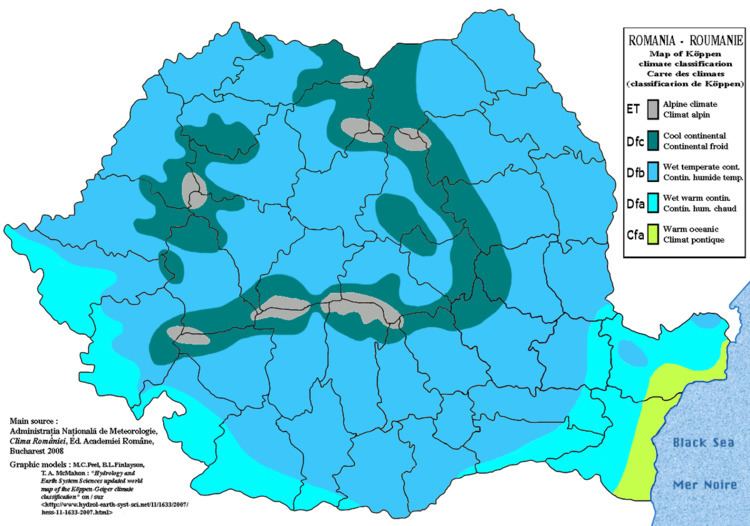 | ||
The climate is temperate continental climate in transition, marked by some oceanic climate influences, Scandinavian-Baltic, mediterranean climate and Black Sea . Thus, In south mediterranean climate is felt , characterized by mild winters and rainfall richer (especially in autumn). In south-east Black Sea climate occurs with rare heavy torrential rains. In eastern regions it's less pronounced continental character. In the north of the country (Maramures and Bucovina) the effect of Scandinavian-Baltic, which causes a wetter and colder climate with cold winters. In the west of the country manifests more pronounced influence of low pressure systems generated over the Atlantic, causing moderate temperatures and richer precipitation. Climate nuances are demonstrated on the steps of the altitude, the mountain ranges of the Carpathian arc being a cool mountain climate with high humidity throughout the year.
The average annual temperature is 11 °C (51.8 °F) in the south and middle-south and 8 °C (46.4 °F) in northeast. In Bucharest, the temperature ranges from average low −5 °C (23 °F) in January to average high 29 °C (84.2 °F) in July and August, with average temperatures of −3 °C (26.6 °F) in January and 23 °C (73.4 °F) in July and August. Rainfall, although adequate throughout the country, decreases from west to east and from mountains to plains. Some mountainous areas receive more than 1,010 mm (39.8 in) of precipitation each year. Annual precipitation averages about 635 mm (25 in) in central Transylvania, 521 mm (20.5 in) at Iaşi in Moldavia, and only 381 mm (15 in) at Constanţa on the Black Sea.
Owing to its distance from the open sea, Romania has a continental climate. Summers are generally very warm to hot, with average maxima in Bucharest being around 29 °C (84.2 °F), with temperatures over 35 °C (95 °F) not unknown in the lower-lying areas of the country. Minima in Bucharest and other lower-lying areas are around 18 °C (64.4 °F), but at higher altitudes both maxima and minima decline considerably.
Winters are quite cold, with average highs even in lower-lying areas being no more than 3 °C (37.4 °F) and below −15 °C (5 °F) in the highest mountains, where some areas of permafrost occur on the highest peaks.
Precipitation is generally modest, averaging over 750 mm (29.5 in) only on the highest western mountains - much of it falling as snow which allows for an extensive skiing industry. In the delta of the Danube, rainfall is very low, averaging only around 370 mm (14.6 in) per year, whilst in the more westerly lowland like Bucharest it is around 530 mm (20.9 in).
Records
The absolute minimum temperature was −38.5 °C (−37.3 °F), registered near Brașov in 1942. The absolute maximum temperature was 44.5 °C (112.1 °F), recorded at Ion Sion, Brăila County in 1951.
